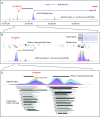NFAT5 and SLC4A10 Loci Associate with Plasma Osmolality
- PMID: 28360221
- PMCID: PMC5533231
- DOI: 10.1681/ASN.2016080892
NFAT5 and SLC4A10 Loci Associate with Plasma Osmolality
Abstract
Disorders of water balance, an excess or deficit of total body water relative to body electrolyte content, are common and ascertained by plasma hypo- or hypernatremia, respectively. We performed a two-stage genome-wide association study meta-analysis on plasma sodium concentration in 45,889 individuals of European descent (stage 1 discovery) and 17,637 additional individuals of European descent (stage 2 replication), and a transethnic meta-analysis of replicated single-nucleotide polymorphisms in 79,506 individuals (63,526 individuals of European descent, 8765 individuals of Asian Indian descent, and 7215 individuals of African descent). In stage 1, we identified eight loci associated with plasma sodium concentration at P<5.0 × 10-6 Of these, rs9980 at NFAT5 replicated in stage 2 meta-analysis (P=3.1 × 10-5), with combined stages 1 and 2 genome-wide significance of P=5.6 × 10-10 Transethnic meta-analysis further supported the association at rs9980 (P=5.9 × 10-12). Additionally, rs16846053 at SLC4A10 showed nominally, but not genome-wide, significant association in combined stages 1 and 2 meta-analysis (P=6.7 × 10-8). NFAT5 encodes a ubiquitously expressed transcription factor that coordinates the intracellular response to hypertonic stress but was not previously implicated in the regulation of systemic water balance. SLC4A10 encodes a sodium bicarbonate transporter with a brain-restricted expression pattern, and variant rs16846053 affects a putative intronic NFAT5 DNA binding motif. The lead variants for NFAT5 and SLC4A10 are cis expression quantitative trait loci in tissues of the central nervous system and relevant to transcriptional regulation. Thus, genetic variation in NFAT5 and SLC4A10 expression and function in the central nervous system may affect the regulation of systemic water balance.
Keywords: human genetics; hypernatremia; hyponatremia; water-electrolyte balance.
Copyright © 2017 by the American Society of Nephrology.
Figures


Similar articles
-
Biallelic variants in SLC4A10 encoding a sodium-dependent bicarbonate transporter lead to a neurodevelopmental disorder.Genet Med. 2024 Mar;26(3):101034. doi: 10.1016/j.gim.2023.101034. Epub 2023 Dec 3. Genet Med. 2024. PMID: 38054405 Free PMC article.
-
Genome-wide association study in Chinese identifies novel loci for blood pressure and hypertension.Hum Mol Genet. 2015 Feb 1;24(3):865-74. doi: 10.1093/hmg/ddu478. Epub 2014 Sep 23. Hum Mol Genet. 2015. PMID: 25249183 Free PMC article.
-
SLC4A10 mutation causes a neurological disorder associated with impaired GABAergic transmission.Brain. 2023 Nov 2;146(11):4547-4561. doi: 10.1093/brain/awad235. Brain. 2023. PMID: 37459438 Free PMC article.
-
Disorders of sodium and water balance in hospitalized patients.Can J Anaesth. 2009 Feb;56(2):151-67. doi: 10.1007/s12630-008-9017-2. Epub 2008 Dec 31. Can J Anaesth. 2009. PMID: 19247764 Review.
-
Nutrition-focused evaluation and management of dysnatremias.Nutr Clin Pract. 2008 Apr-May;23(2):108-21. doi: 10.1177/0884533608314531. Nutr Clin Pract. 2008. PMID: 18390778 Review.
Cited by
-
Heritability and individuality of the plasma sodium concentration: a twin study in the United States veteran population.Am J Physiol Renal Physiol. 2019 Jun 1;316(6):F1114-F1123. doi: 10.1152/ajprenal.00581.2018. Epub 2019 Mar 25. Am J Physiol Renal Physiol. 2019. PMID: 30908934 Free PMC article.
-
Direct ionic stress sensing and mitigation by the transcription factor NFAT5.bioRxiv [Preprint]. 2023 Sep 24:2023.09.23.559074. doi: 10.1101/2023.09.23.559074. bioRxiv. 2023. Update in: Sci Adv. 2025 Feb 21;11(8):eadu3194. doi: 10.1126/sciadv.adu3194. PMID: 37886503 Free PMC article. Updated. Preprint.
-
Plasma sodium, extracellular fluid volume, and blood pressure in healthy men.Physiol Rep. 2021 Dec;9(24):e15103. doi: 10.14814/phy2.15103. Physiol Rep. 2021. PMID: 34921521 Free PMC article.
-
Multiple acid-base and electrolyte disturbances upregulate NBCn1, NBCn2, IRBIT and L-IRBIT in the mTAL.J Physiol. 2020 Aug;598(16):3395-3415. doi: 10.1113/JP279009. Epub 2020 May 30. J Physiol. 2020. PMID: 32359081 Free PMC article.
-
Dietary sodium enhances the expression of SLC4 family transporters, IRBIT, L-IRBIT, and PP1 in rat kidney: Insights into the molecular mechanism for renal sodium handling.Front Physiol. 2023 Apr 4;14:1154694. doi: 10.3389/fphys.2023.1154694. eCollection 2023. Front Physiol. 2023. PMID: 37082243 Free PMC article.
References
-
- Adrogué HJ, Madias NE: Hyponatremia. N Engl J Med 342: 1581–1589, 2000 - PubMed
-
- Miller M: Hyponatremia and arginine vasopressin dysregulation: Mechanisms, clinical consequences, and management. J Am Geriatr Soc 54: 345–353, 2006 - PubMed
-
- Vachharajani TJ, Zaman F, Abreo KD: Hyponatremia in critically ill patients. J Intensive Care Med 18: 3–8, 2003 - PubMed
-
- Adrogué HJ, Madias NE: Hypernatremia. N Engl J Med 342: 1493–1499, 2000 - PubMed
-
- Kugler JP, Hustead T: Hyponatremia and hypernatremia in the elderly. Am Fam Physician 61: 3623–3630, 2000 - PubMed
MeSH terms
Substances
Grants and funding
LinkOut - more resources
Full Text Sources
Other Literature Sources
Medical
Molecular Biology Databases

